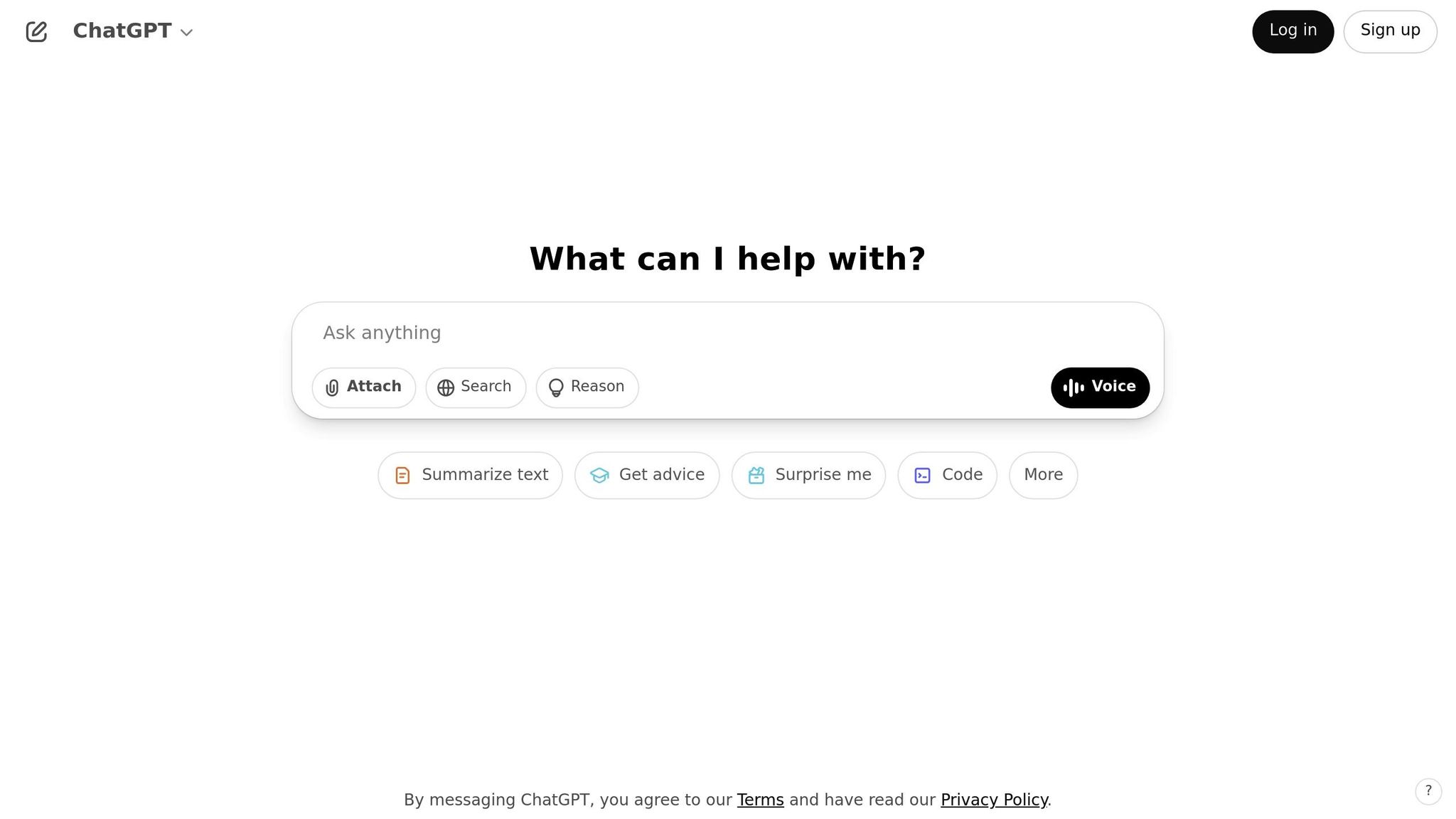
AI agents are transforming businesses, but their costs go beyond initial setup. Here's a quick breakdown:
Feature
ChatGPT (GPT-4)
Claude (3.7 Sonnet)
Qwen-Turbo
Input Cost (per 1K tokens)
$0.03
$3.00
$0.00005
Output Cost (per 1K tokens)
$0.06
$15.00
$0.0002
Context Window
8,192 tokens
Varies by model
1,008,192 tokens
Monthly Plans
Custom pricing
$15–$75
Pay-as-you-go
AI agents can double productivity, but planning for all costs is essential to maximize ROI.

ChatGPT's pricing involves several components essential for its deployment. The API costs depend on the model: GPT-3.5 is priced at $0.002 per 1,000 tokens, while GPT-4 costs $0.03 per 1,000 prompt tokens and $0.06 per 1,000 completion tokens.
Development and integration costs can vary significantly. Freelancers typically charge $20–$100 per hour, while agencies may require $5,000–$20,000 for their services. For simpler setups, no-code platforms like Landbot.io start at $39 per month.
Infrastructure expenses also play a role. Basic deployments on platforms like AWS or Heroku can range from $5 to $50 per month, while medium-scale cloud servers cost between $50 and $200 per month. Additional infrastructure expenses include:
Component
Monthly Cost Range
User Authentication
Free to $0.01 per user
Database (
)
Free to $50
Cloud Hosting
$500 to $3,000
For a mid-sized app handling 100,000 queries per month, API fees alone might amount to $3,000–$7,000.
The return on investment (ROI) for ChatGPT is promising. AI-powered chat can increase user session lengths by 30–50% and automate 50–70% of support tickets. This can result in monthly savings exceeding $10,000 and boost e-commerce sales by 10–20%. These benefits make ChatGPT a valuable tool for improving business efficiency.
To reduce costs, businesses can use strategies like caching, limiting API calls, or selecting between GPT-3.5 and GPT-4 based on their specific needs. Initial development costs may vary, with estimates of $10,000–$25,000 for serving 5,000 users and $30,000–$80,000 for 50,000 users. Up next, we'll explore how other AI agents compare in terms of costs.

Claude offers a pricing structure that differs from ChatGPT's detailed plans. It provides three subscription tiers: Standard Access for $15 per month, Enterprise Access for $75 per month, and Claude Pro for $20 per month.
For API integration, costs depend on the model chosen. Here's a breakdown:
Model
Input Cost (per million tokens)
Output Cost (per million tokens)
Claude 3 Haiku
$0.80
$4.00
Claude 3.5 Sonnet
$3.00
$15.00
Claude 3 Opus
$15.00
$75.00
For example, if a company processes 500,000 tokens using Claude 3 Opus, they would spend about $7.50 on input costs and $37.50 on output costs. The platform operates on prepaid usage credits, helping users manage expenses efficiently.
The pricing covers a range of services, including computational resources, research and development, data management, system maintenance, and customer support. Claude also offers custom deployment options - either cloud-based or on-premises - for added security and performance.
Next, we’ll look at Qwen’s pricing model.

Qwen uses a tiered pricing model to match its services to different needs and budgets. Below is a breakdown of the costs for processing tokens and the maximum context window available for each model:
Model
Input Cost (per 1K tokens)
Output Cost (per 1K tokens)
Context Window
Qwen-Max
$0.0016
$0.0064
32,768 tokens
Qwen-Plus
$0.0004
$0.0012
131,072 tokens
Qwen-Turbo
$0.00005
$0.0002
1,008,192 tokens
The platform operates on a pay-as-you-go system with no upfront costs, giving businesses the flexibility to scale usage as needed while managing expenses effectively.
Qwen includes built-in features designed to help businesses reduce costs:
To optimize costs for large-scale operations, businesses can combine Qwen-Turbo for high-volume tasks with Qwen-Max for complex processing. This approach can cut costs by up to 40%. Additionally, response caching can reduce per-call expenses from $0.0005 to $0.0001.
Qwen-Turbo’s extensive context window - supporting up to 1,008,192 tokens - allows larger documents to be processed in a single pass. This reduces the need for multiple API calls and minimizes overhead.
Alibaba’s Model Observation dashboard provides real-time insights into token usage and expenses.
For businesses handling high volumes, Qwen-Turbo offers significant savings, cutting costs by up to 96.9% compared to Qwen-Max. This makes it a cost-effective choice for scaling AI operations.
This section examines the pricing and overall value of ChatGPT, Claude, and Qwen, focusing on both direct costs and additional expenses. By analyzing these details, we can better understand the return on investment (ROI) for each option.
Feature
ChatGPT (GPT-4o)
Claude (3.7 Sonnet)
API Input Cost (per 1M tokens)
$2.50
$3.00
API Output Cost (per 1M tokens)
$10.00
$15.00
Enterprise Features
Custom pricing
Custom pricing
For businesses with high usage, monthly costs depend on token volume, subscription fees, and any custom enterprise pricing. Estimating token consumption is crucial for understanding potential expenses.
Beyond listed prices, there are hidden expenses like integration, training, and ongoing maintenance. The complexity of integrating the system and the frequency of updates can significantly influence total costs.
Tiered pricing models and enterprise discounts help manage expenses as usage increases. These structures allow businesses to scale operations without losing cost efficiency.
AI tools improve efficiency by reducing manual tasks, enhancing data analysis, and creating better customer experiences. These benefits make the investment worthwhile for various applications and workloads.
AI agents offer both operational and strategic benefits:
When deploying AI agents, it's crucial to account for both direct and indirect expenses. OpenAI's projected $1 billion revenue by 2024 highlights the rapid growth and investment in AI technologies.
Here are some practical ways to manage costs effectively:
To keep AI deployment costs under control, organizations should:
The key is to balance upfront expenses with the long-term value. Choose solutions that not only meet your current needs but can also scale as you grow.
To reduce hidden costs when using AI agents, businesses can adopt several practical strategies:
Additionally, matching the complexity of tasks to the appropriate AI model can help avoid overpaying for unnecessary capabilities. By implementing these strategies, businesses can effectively manage their AI-related expenses while maximizing value.
The size of the context window directly affects both the cost and efficiency of AI agents. A larger context window allows the AI to process more information in a single interaction, which can improve accuracy and reduce the need for follow-up queries. However, it also increases token usage, leading to higher costs.
On the other hand, smaller context windows are more cost-effective since they use fewer tokens per interaction. However, they may require additional API calls to provide the necessary context, which could impact overall efficiency. Striking the right balance between window size and usage is key to optimizing costs while maintaining performance.
To ensure the best ROI when selecting AI agents, businesses should evaluate both upfront costs and operational expenses. Upfront costs may include development fees for custom solutions or subscription fees for pre-built agents. Operational expenses, such as compute costs for processing large language models (LLMs), orchestration, and tool execution, can scale with usage and should be factored in.
Additionally, consider the complexity of your use case, the level of customization required, and the expected volume of API calls. Hidden costs like training, integration, and ongoing maintenance can also impact your budget. By understanding these factors, businesses can make informed decisions and align AI investments with their operational goals.
{"@context":"https://schema.org","@type":"FAQPage","mainEntity":[{"@type":"Question","name":"How can businesses reduce hidden costs when deploying AI agents?","acceptedAnswer":{"@type":"Answer","text":"<p>To reduce hidden costs when using AI agents, businesses can adopt several practical strategies:</p> <ul> <li><strong>Streamline prompts</strong>: Use clear, concise instructions to minimize unnecessary token usage and processing time. Shorter, more focused prompts can significantly lower costs.</li> <li><strong>Control response length</strong>: Set limits on response length to avoid excessive verbosity and reduce computational expenses.</li> <li><strong><a href=\"https://www.godofprompt.ai/chatgpt-free/apply-lean-workflow-techniques\">Optimize workflows</a></strong>: Break complex tasks into smaller, manageable steps to use AI more efficiently and save resources.</li> </ul> <p>Additionally, matching the complexity of tasks to the appropriate AI model can help avoid overpaying for unnecessary capabilities. By implementing these strategies, businesses can effectively manage their AI-related expenses while maximizing value.</p>"}},{"@type":"Question","name":"How does the size of the context window affect the cost and efficiency of using AI agents like Qwen-Turbo?","acceptedAnswer":{"@type":"Answer","text":"<p>The size of the context window directly affects both the cost and efficiency of AI agents. A larger context window allows the AI to process more information in a single interaction, which can improve accuracy and reduce the need for follow-up queries. However, it also increases token usage, leading to higher costs.</p> <p>On the other hand, smaller context windows are more cost-effective since they use fewer tokens per interaction. However, they may require additional API calls to provide the necessary context, which could impact overall efficiency. Striking the right balance between window size and usage is key to optimizing costs while maintaining performance.</p>"}},{"@type":"Question","name":"What should businesses evaluate when selecting AI agents to ensure the best return on investment?","acceptedAnswer":{"@type":"Answer","text":"<p>To ensure the best ROI when selecting AI agents, businesses should evaluate both <strong>upfront costs</strong> and <strong>operational expenses</strong>. Upfront costs may include development fees for custom solutions or subscription fees for pre-built agents. Operational expenses, such as compute costs for processing large language models (LLMs), orchestration, and tool execution, can scale with usage and should be factored in.</p> <p>Additionally, consider the <strong>complexity of your use case</strong>, the level of customization required, and the expected volume of API calls. Hidden costs like training, integration, and ongoing maintenance can also impact your budget. By understanding these factors, businesses can make informed decisions and align AI investments with their operational goals.</p>"}}]}





